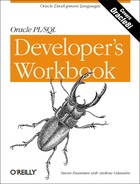Chapter 26. Using Java with PL/SQL
Beginner
Intermediate
Expert
Q: | |
26-22. | The DDL statement to create the call spec will work fine; it won’t report any creation errors. When you attempt to execute the my_hello procedure, however, you receive an error message stating that there is no method named doIt in the class. The problem is that the method’s name is doit, not doIt (remember, case matters in Java!). To fix the problem, you must change the call spec to match the method name. Here’s the output from SQL*Plus: SQL> SET SERVEROUTPUT ON SQL> EXEC DBMS_JAVA.SET_OUTPUT(1000); PL/SQL procedure successfully completed. SQL> CREATE OR REPLACE PROCEDURE my_hello 2 AS LANGUAGE JAVA 3 NAME 'helloWorld.doIt()'; 4 / Procedure created. SQL> EXEC my_hello java.lang.NoSuchMethodException: No applicable method found .. BEGIN my_hello; END; * ERROR at line 1: ORA-29531: no method doIt in class helloWorld ORA-06512: at "SCOTT.MY_HELLO", line 0 ORA-06512: at line 1 |
Q: | |
26-23. | As in the previous exercise, the call spec compiles but doesn’t run. The problem in this case is that you can publish only static methods. To fix the problem, add the static keyword to the definition of doit, recompile, and reload the class. |
Q: | |
26-24. | The following query displays information about the Java objects in a user schema: SELECT object_name, object_type, status, timestamp
FROM user_objects
WHERE (object_name NOT LIKE 'SYS_%'
AND object_name NOT LIKE 'CREATE$%'
AND object_name NOT LIKE 'JAVA$%'
AND object_name NOT LIKE 'LOADLOB%')
AND object_type LIKE 'JAVA %'
ORDER BY object_type, object_name; |
Q: | |
26-25. | The following procedure is an example of how to fetch the source code for a JSP into a CLOB, and then print it (note that you need a more sophisticated method to print bigger source files!):
|
Q: | |
26-26. | The smallestFirst method swaps the parameter values so that the smallest one comes first. Since the parameters change, you must declare your corresponding PL/SQL parameters as IN OUT: CREATE OR REPLACE PROCEDURE smallest_first (a IN OUT NUMBER, b IN OUT NUMBER) AS LANGUAGE JAVA NAME 'NumberTest.smallestFirst(int[], int[])'; The following listing shows the results if you make the parameters IN only: SQL> CREATE OR REPLACE PROCEDURE smallest_first
2 (a IN NUMBER, b IN NUMBER)
3 AS LANGUAGE JAVA
4 NAME 'NumberTest.smallestFirst(int[], int[])';
5 /
Procedure created.
SQL> declare
2 x number := 100;
3 y number := 10;
4 begin
5 dbms_output.put_line ('X => ' || x || ', y=> ' || y);
6 smallest_first (x,y);
7 dbms_output.put_line ('X => ' || x || ', y=> ' || y);
8 end;
9 /
X => 100, y=> 10
java.lang.NullPointerException
at NumberTest.smallestFirst(NumberTest.java:3)
declare
*
ERROR at line 1:
ORA-29532: Java call terminated by uncaught Java exception:
java.lang.NullPointerException
ORA-06512: at "SCOTT.SMALLEST_FIRST", line 0
ORA-06512: at line 6 |
Q: | |
26-27. | The missing component is “oracle.sql.STRUCT”, which passes complex Oracle object datatypes to Java. |
Q: | |
26-28. | Here is the specification for the basic file-operations package, along with the definition for the file_list_t type: CREATE TYPE file_list_t IS TABLE OF VARCHAR2(2000);
/
CREATE OR REPLACE PACKAGE basic_file_ops
IS
FUNCTION length (file IN VARCHAR2) RETURN NUMBER;
FUNCTION delete (file IN VARCHAR2) RETURN BOOLEAN;
PROCEDURE getDirContents (
dir IN VARCHAR2,
files IN OUT file_list_t);
END; |
Q: | |
26-29. | One of the principles of good design is to remove hardcoded values (sometimes called magic values) from programs by replacing them with constants or functions. This technique frees you from worrying how Java represents a Boolean true; whether the class uses a 1, –1, or even 3.1459 is not your concern. You just have to make sure your PL/SQL program interprets these values correctly. The easiest way to do this is to store the return values of the Java “get” methods in packaged variables, which you can then use in place of literal values. First, you need three private, global variables to hold the Java literals. Second, you need three functions to return the literal values that represent true, false, and the filename delimiter. Finally, you need to use the package-initialization section to actually store the function’s return value into the appropriate variable. Here’s the code:
|
Q: | |
26-30. | The easiest way to implement the delete-file function is to put a wrapper around the call spec to convert the results of the Java function into a PL/SQL Boolean value. This technique comes in handy in situations where you want to massage the results from a Java call:
|
Q: | |
26-31. | The function to retrieve the file’s size is straightforward: FUNCTION length (file IN VARCHAR2) RETURN NUMBER
AS LANGUAGE JAVA
NAME 'JFile.length (java.lang.String) return long'; |
Q: | |
26-32. | As with the delete function, you implement the getDirContents file with two procedures. The first simply retrieves the delimited string returned by the Java function. The second parses the string and places each element into a PL/SQL table:
|
Q: | |
26-33. | You must grant the JAVAUSERPRIV role to a schema before it can read or write a file. Then you must grant the JAVASYSPRIV role to create or delete files. For example: GRANT JAVAUSERPRIV TO SCOTT; GRANT JAVASYSPRIV TO BIG_SCHEMA; Finally, modify the UTL_FILE_DIR in INIT.ORA to specify the accessible directories: utl_file_dir = c: emp |
